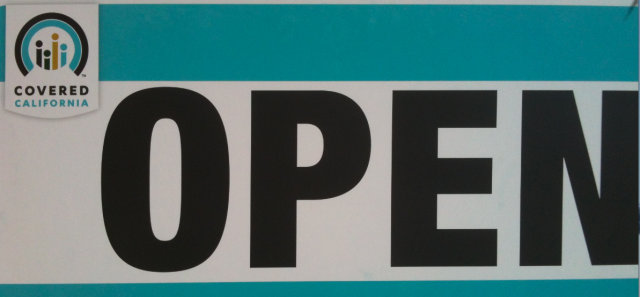“There are tons of people who don’t know what’s going on today,” said Valerie Lopez, an outreach worker at the center.
Pena explained to the patients at the health center that starting Tuesday, they could sign up for new health coverage that would begin Jan. 1. Depending on their income, they would either qualify for free insurance through Medicaid (called Medi-Cal here) or for discounted private insurance through Covered California, the state’s online health insurance marketplace. And she warned about the penalty that most people who don’t have insurance would face in 2014.
The patients asked many questions: Do I have to pay a fine if I am not working? Do I still qualify for Medi-Cal if I own a home? Are there people to help me fill out the application? Pena didn’t know all the answers, but she said people would be available soon to help with enrollment. There was no one at the center who could actually help people enroll. They are still being trained.
The Obama administration is counting on outreach efforts to enroll Latinos and other immigrants. They tend to be younger than the general population, and so they balance out the costs of older, sicker people in the insurance pool.
Getting the information out to immigrants is an uphill battle, said Reshma Shamasunder, executive director of the California Immigrant Policy Center. Many speak little or no English. They also may live in mixed-status families, where some are eligible for new insurance options and others aren’t. And after years of deportations throughout immigrant communities, the distrust of government is high, she added.
“It is going to be important to have trusted messengers in their communities,” she said.
Health clinic administrators say they hope their staff members will be those messengers. “Once patients establish that rapport and that trust, they are going to look for us for information,” said Frances Bernabe, director of clinic operations for the Wesley Health Centers.
Even if they are successful with their outreach efforts, California officials know millions could remain uninsured. A UC Berkeley study last year found that as many as 4 million Californians could still be without insurance in 2019 and nearly three-quarters will be U.S. citizens or legal residents. Two-thirds remaining uninsured will be Latino.
About 1 million of those remaining uninsured will be immigrants not in the country legally, the study said. The law bars undocumented immigrants from getting insurance from the exchanges, even if they pay for it themselves.
[Related: Obamacare Explained — A Guide for Californians (in English and Spanish)]
Celia Figueroa limped into the Bell Gardens clinic early Tuesday morning, hoping to see a doctor about a lingering pain in her knee. A doctor told her years ago that she needs surgery but Figueroa said she can’t afford it.
Figueroa, 57, who is uninsured, said she has heard of the health law but doesn’t know what it does or if she qualifies for it. “I don’t know anything about Obamacare,” she said.
Monica Delgado, 32, listened to the presentation by the outreach workers but knew none of it applied to her because she is in the country illegally. Delgado, who works as a housekeeper, said she feels frustrated that she can’t take advantage of the new coverage options.
“This is unequal because it’s not for everybody,” she said. “But everybody gets sick.”
Delgado came to the clinic Tuesday morning because her daughter, who is covered by Medi-Cal, had a spider bite. Without insurance, she said she would continue relying on the clinic, where she can get care for free.
In an effort to get the word out to Latinos, Covered California is running ads in both English and Spanish, and officials have translated information about the new insurance options into Spanish.
Covered California has also awarded millions in grants to organizations working with Latinos and other ethnic groups to help people to enroll.
On Monday afternoon at another Los Angeles clinic, St. John's Well Child & Family Center, Maria Gomez, 58, said she pays in cash when she goes to the doctor or has to buy medication. Gomez, a legal resident from Mexico, came to the center for more information about the health law.
When she learned she would be eligible for expanded Medi-Cal coverage, she said. “Finally, I am going to have insurance. I feel happy.”
Kaiser Health News (KHN) is a nonprofit news organization covering health care policy and politics. It is an editorially independent program of the Kaiser Family Foundation.
